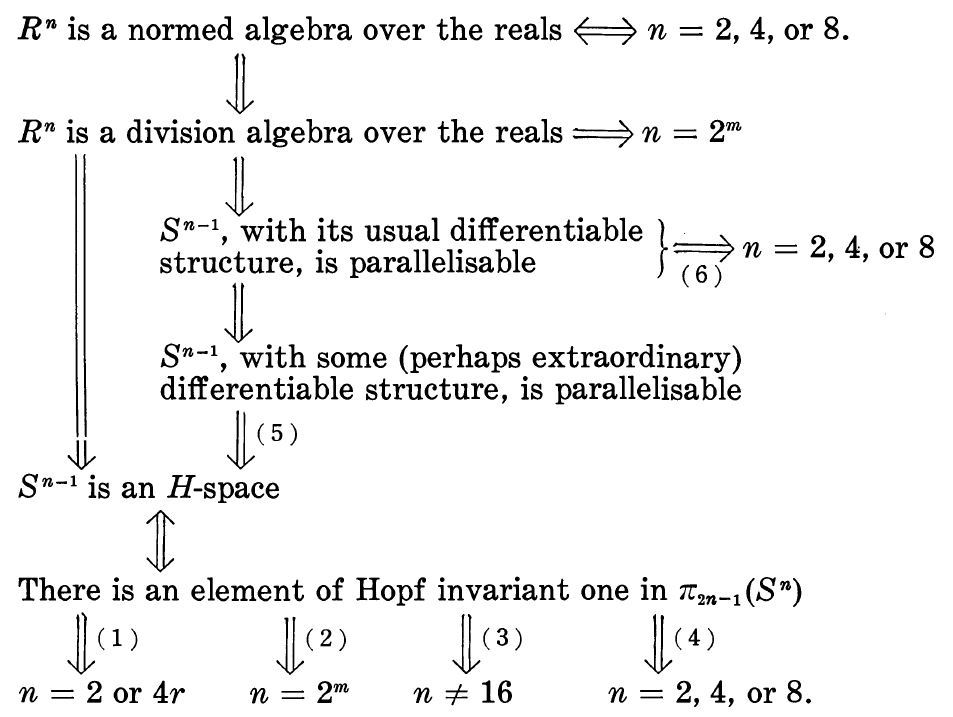nLab Hopf invariant one
Context
Homotopy theory
homotopy theory, (∞,1)-category theory, homotopy type theory
flavors: stable, equivariant, rational, p-adic, proper, geometric, cohesive, directed…
models: topological, simplicial, localic, …
see also algebraic topology
Introductions
Definitions
Paths and cylinders
Homotopy groups
Basic facts
Theorems
Contents
Idea
In algebraic topology, Hopf invariant one refers to homotopy classes of continuous functions between spheres of the form
hence to elements in the homotopy groups of spheres
whose Hopf invariant is equal to one:
Often this is regarded not in the integers but in its quotient to the cyclic group of order 2 , where it hence says that the actual integer value is an odd number.
The Hopf invariant one problem, once a famous open problem, solved in Adams 60, is the classification of maps for which Hopf invariant is indeed equal to one.
Properties
Relation to H-space structure and normed division algebras
The existence of an element of Hopf invariant one in is equivalent to the existence of an H-space structure on .
A celebrated theorem due to (Adams 60, introducing and using the Adams spectral sequence) states that maps of Hopf invariant one correspond precisely to the the Hopf constructions on the four normed division algebras (see also at Hurwitz theorem): the real Hopf fibration, the complex Hopf fibration, the quaternionic Hopf fibration and the octonionic Hopf fibration.

(Adams 60)
History
Stable homotopy theory emerged as a distinct branch of algebraic topology with Adams‘ introduction of his eponymous spectral sequence and his spectacular conceptual use of the notion of stable phenomena in his solution to the Hopf invariant one problem.
Related concepts
exceptional spinors and real normed division algebras
References
The original proof that the only maps of Hopf invariant one are the Hopf constructions on the four normed division algebras is due to
-
John F. Adams, On the non-existence of elements of Hopf invariant one, Ann. Math. 72 1 (1960) 20-104 [jstor:1970147]
-
John F. Adams, Section 8 of: On the groups IV, Topology 5 21 (1966) [pdf, doi:10.1016/0040-9383(66)90004-8]
and made use of the classical Adams spectral sequence.
Review:
-
Doug Ravenel, chapter 1, section 2 in: Methods of computing in: Complex cobordism and stable homotopy groups of spheres
-
John Rognes, around lemma 4.14, theorem 4.15 of The Adams spectral sequence, 2012 (pdf)
-
Joseph Victor, Section 2.4 of Stable Homotopy Groups of Spheres and The Hopf Invariant One Problem, 2013 (pdf)
Comments on the impact of this proof on the development of stable homotopy theory:
- Anthony Elmendorf, Igor Kriz, Peter May, Modern foundations for stable homotopy theory, in Ioan Mackenzie James, Handbook of Algebraic Topology, Amsterdam: North-Holland, (1995) pp. 213–253, (pdf)
Another proof that instead uses topological K-theory, Adams operations and the Atiyah-Hirzebruch spectral sequence was given in
- John F. Adams, Michael Atiyah, K-theory and the Hopf invariant, Quart. J. Math. Oxford 17 1 (1966) 31-38 [pdf, doi:10.1093/qmath/17.1.31]
see also Adams 66, Sections 7, 8.
Review of the Hopf invariant one problem via Adams operations in topological K-theory:
-
Dale Husemöller, chapter 15 of Fibre Bundles, Graduate Texts in Mathematics 20, Springer New York (1966)
-
Klaus Wirthmüller, section 12 of: Vector bundles and K-theory, 2012 (pdf)
-
Allen Hatcher, section 2.3 of Vector bundles and K-theory (web)
-
Marcelo Aguilar, Samuel Gitler, Carlos Prieto, section 10.6 of; Algebraic topology from a homotopical viewpoint, Springer (2002) [toc pdf]
-
Michael Hopkins (notes by Akhil Mathew), Lecture 9 in: Spectra and stable homotopy theory, 2012 (pdf, pdf)
-
Gereon Quick, The Hopf invariant one problem via K-theory, lecture notes in: Advanced algebraic topology, 2014 (pdf)
-
Ishan Banerjee, The Hopf invariant one problem, 2016 (pdf)
Review using the BP-Adams-Novikov spectral sequence includes
- Doug Ravenel, chapter 5, section 2 Complex cobordism and stable homotopy groups of spheres
Last revised on November 16, 2023 at 02:49:45. See the history of this page for a list of all contributions to it.